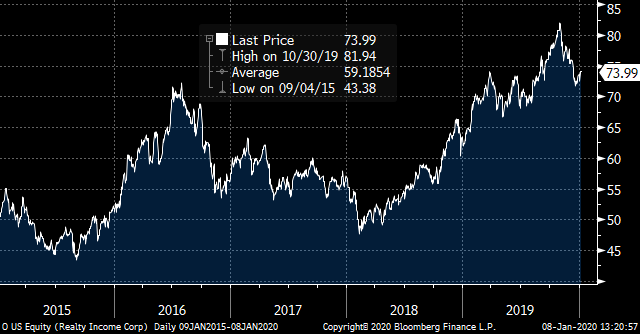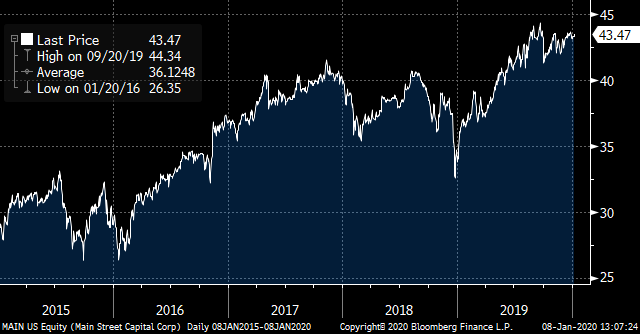We all have bills and expenses each and every month. However, when it comes to investing in dividend-paying stocks, there’s always been a mismatch between when you get paid dividend distributions and when you cut checks or click to make your payments.
This is because the vast number of U.S.-listed companies pay their dividends on a quarterly basis. And beyond the borders of the nation, many companies stretch out their distributions to bi-annual or even annual payments. The argument is that only after the company does its business and its fiscal year is wrapped up should it spread cash crumbs out to pesky shareholders.
But that’s not how the folks residing in C-Suites view their own renumerations. They prefer to pay themselves every so many weeks with bonuses and other perks throughout the year.
But there is a collection of companies that don’t see shareholders as a burden — but rather as the rightful owners of the company. And as such, they are paid regularly each and every month, often with rising levels of distributions for attractive dividend yields. And these yields work to build up a retirement portfolio more quickly through reinvestment. Later they will provide monthly income.
Moreover, the dividends paid are ample. Every one of the stocks in the following collection yields more than the average S&P 500 yield — which is a mere 1.8%. And in many cases, the dividend yields are multiples of that average.
Where do these monthly dividend stocks come from? These companies tend to be cash-cow businesses that provide dependable profits. Because when you invest for dividends, you need to own stocks from companies that you can rely on.
I’ve assembled a nice collection of stocks to bump up your own portfolio’s cash payouts with monthly dividends.
Monthly Dividend Stocks: Realty Income (O)

Dividend Yield: 3.7%
Mention retailers and many investors will think of the doom brought by Amazon (NASDAQ:AMZN) and other online behemoths. But a website can’t replace all retail. In fact, one of the more pervasive members of the retail space actually benefits from the surge of online shopping. That would be FedEx (NYSE:FDX), which operates thousands of stores that facilitate all of the returns from American households’ online spending sprees.
Then there’s another retail space that gets attention — especially at the start of each year. Gyms are always in demand. Either for those that need or want to lose extra pounds or those that want to keep them off while staying in better health, gyms are a reliable part of the American retail space. And one of the leaders in this retail market space is LA Fitness, now owned by a private equity company called Mid-Ocean Partners.
Then we have one of the major go-to retailers when it comes to picking up prescription drugs. Walgreens Boots Alliance (NASDAQ:WBA) is one of the leaders in local pharmacies. It’s also a prime place to pick up last-minute health, beauty, food and household items. Even Amazon’s Amazon Now can’t always compete.
And one of the other prime retail spaces that’s also a defense against online vendors belongs to the super-discounted dollar stores. These stores are found in urban, suburban and rural areas where they provide bargain buys that are made by all kinds of consumers on a regular basis. They tend to have sticky and reliable customers making for good retail space. And two of the leaders include Dollar General (NYSE:DG) and Dollar Tree (NASDAQ:DLTR).
Realty Income Is All About Retail
What do the five companies all have in common? They are all long-term triple-net lease customers of Realty Income (NYSE:O). Triple-net leases are arrangements where tenants pay rent as well as taxes, general upkeep and insurance costs. This setup limits risks and expenses for the owners of the leased properties.
Realty Income is a real estate investment trust (REIT). Its top tenants are represented by the companies above, leasing thousands of properties across the American marketplace.
Revenues are rising across the portfolio, with gains running on an average annual basis of 9.1% over the past three years alone.
This supports a nice monthly dividend distribution, which Realty Income continues to raise at an average annual rate of 4.4% over the past five years alone. And with a current dividend yield of 3.7% it too makes for a great monthly inflation-trouncing dividend payer. O stock will round out my nice collection for your retirement portfolio right now. And to make it even better, thanks to the Tax Cuts and Jobs Act of 2017, 20% of the dividend distribution income is deductible from taxable income for most individual investors.
Main Street Capital (MAIN)

Dividend Yield: 6.7%
Just as retail is being upended by market changes, so too is business banking. Traditional banks — with onerous regulations and capital requirements — are seeing more of their core lending markets taken over by a collection of companies designed to do just that.
Main Street Capital (NYSE:MAIN) is set up as a business development company (BDC). BDCs are codified under the Small Business Investment Incentive Act of 1980. This act passed by Congress and signed by then-President Jimmy Carter came as the U.S. economy was in a pickle. Inflation was a problem and banks were reticent to lend to smaller and middle-market companies. Banks worried about the inflation risk of fixed lending facilities as well as the underlying credit risks in the business sector.
The resulting legislation extended the Investment Companies Act of 1940, which enabled the formation of non-bank companies. These non-banks would be largely exempt from corporate income taxes if they made loans and equity participation investments in small and middle-market companies.
These new companies functioned as pass-through securities. Investors receive the majority of profits — and the majority isn’t subject to corporate taxes. This means the companies have even more cash on hand for dividend distributions.
Non-Bank Lenders Are a ‘Main’ Source of Revenue
Main Street makes loans to companies in the $10 million to $100 million revenue range. This is exactly what the U.S. market needs. In the wake of the 2007-2008 financial crisis, those traditional middle-market bank lenders have been largely sidelined. They face intense regulatory and capital rules stemming from post-crisis legislative and administrative responses. And while there’s been a great deal of reform, many have turned to Main Street and other non-bank lenders.
Main Street gets to make loans with fewer costs. The result is that its efficiency ratio (a prime measure of the cost to earn each dollar of revenue) is a fraction of those of middle-market lending banks. This means that its costs are lower, and profitability is much higher.
Revenues are rising with gains running at an annual basis of 12.3% on average over the past three years.
The revenues and profitability fuel a rising dividend distribution which has been climbing by an average annual rate of 2.7% over the past five years. And with a monthly payout yielding an annual rate of 5.7%, Main Street is a great way to earn monthly dividend payouts. But it gets a little better. The company has been introducing regular special dividend payments including two last year. This brings the annual dividend to a yield of 6.7%.
EPR Properties (EPR)

Dividend Yield: 6.4%
EPR Properties (NYSE:EPR) is a REIT which focuses on a very risk-controlled and efficient way to profit from real estate assets — triple-net leases. In a triple-net lease, the tenant is also responsible for taxes, insurance and general maintenance costs, hence the term “triple.” Realty Income uses the same arrangements.
This means that EPR acquires properties that have few additional costs over their leased lifespans. What does this mean? There are fewer management costs and less uncertainty. For EPR, there’s also less risk from changes in taxes or insurance costs. Because of this, EPR can run more efficiently in its operations. This means more certainty in cash flows from its portfolio of properties. That cash in turn supports more stable revenues for dividend payouts.
EPR focuses on educational properties, entertainment facilities and resort properties. It wants to both educate your children and keep them entertained on holiday. It’s a profitable dynamic.
Books and Movies and Water Parks, Oh My
For eager students, educational properties include early educational centers and both charter and private schools. These provide stable, reliable tenants that commit to long-term leases. In order to retain their student populations, it is more likely that these educational tenants will renew their long-term leases.
The entertainment facilities are largely leased to movie “megaplex” theaters from both national and international chains.
Rounding out its holdings are a varied mix of resort facilities. These properties include major ski resorts like Camelback Mountain, resorts and golf courses from operator Topgolf. And EPR also owns a collection of water parks in prime locations. All of these benefit from the consumer trend of experience spending which supports longer-term commitments from the operators of the properties and facilities.
All in all, the properties of EPR have been increasing revenues significantly with average annual gains running at 18.5% for the past three years alone.
The triple-net leases from the properties continue to support significant dividend distributions. The distributions continue to rise by an average annual basis of 5.6% over the past five years alone. And with a current yield of 6.4%, EPR is a great monthly dividend payer. And like for other U.S. REITs, the Tax Cuts and Jobs Act provided a line-item tax break for individual investors with a 20% deduction in taxable income from the dividend distributions. This shows up in the 1099-DIV form in Box 5 provided by your brokerage, bank or investment company.
Neil George was once an all-star bond trader, but now he works morning and night to steer readers away from traps — and into safe, top-performing income investments. Neil’s new income program is a cash-generating machine … one that can help you collect $208 every day the market’s open. Neil does not have any holdings in the securities mentioned above.
